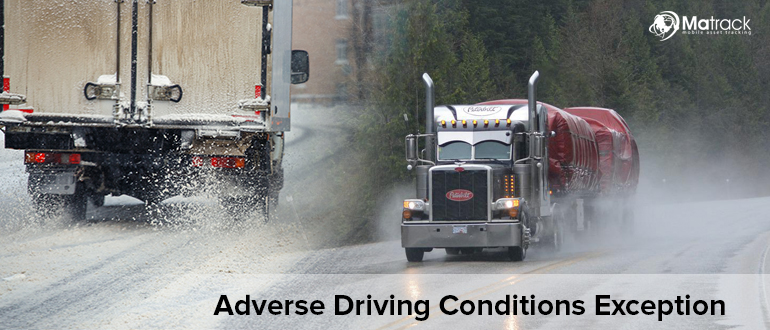Key Takeaways
- The Adverse Driving Conditions Exception lets drivers extend their driving and on-duty hours by 2 hours during unexpected hazards.
- Drivers must record delays in their ELD with details like the reason and proof of the unexpected conditions.
- The exception helps drivers stay safe by reducing the need to rush during bad weather or road issues.
- Tools like Matrack ELD make it easy to track hours, stay compliant, and use the exception correctly.
What Is The Adverse Driving Conditions Exception?
Adverse Driving Conditions exception is unexpected situations that make driving unsafe, such as severe weather or sudden road hazards. Examples include snow, ice, fog, heavy rain, or accidents that could not have been predicted before starting the trip.
These conditions must be unforeseen and unknown to the driver or motor carrier when the trip begins or after a rest break. Routine delays like traffic jams or planned road closures are not considered adverse conditions.
Adverse conditions are important because they create serious safety risks, such as poor visibility and slippery roads. Recognizing these hazards helps drivers make safer decisions and navigate challenging situations effectively.
HOS Regulations Summary
Hours of Service (HOS) regulations are rules established by the FMCSA to ensure truck drivers rest adequately and avoid overworking. These rules apply to property-carrying commercial motor vehicle (CMV) drivers and prioritize safety.
- Drivers can operate their vehicles for a maximum of 11 hours within a 14-hour shift.
- An Electronic Logging Device (ELD) is required to record duty status regularly.
- Rules include minimum off-duty rest periods between shifts and weekly limits to reset hours.
- The Adverse Driving Conditions Exception allows extra time for unexpected hazards like weather or accidents.
- In September 2020, FMCSA updated HOS rules, including changes to the Adverse Driving Conditions Exception.
What Does the Exemption for Adverse Driving Conditions Serve?
The Adverse Driving Conditions Exception protects drivers from penalties for delays caused by situations beyond their control. It allows them to continue their trip safely without putting themselves or others at risk.
This exception provides several key benefits:
- Improved Safety: Helps drivers manage risks during bad weather, reducing accidents and protecting lives and cargo.
- Compliance Benefits: Supports better FMCSA Compliance, Safety, Accountability (CSA) scores.
- Reduced Pressure: Prevents drivers from rushing to beat weather conditions, lowering the chances of speeding or risky driving.
- Crash Prevention: Minimizes the risk of fatigue-related crashes by giving drivers extra time to complete their trips safely. Read more about crash prevention.
Applying the Adverse Driving Conditions Exception
The Adverse Driving Conditions Exception applies only when unexpected weather or traffic conditions occur during a driver’s trip. Drivers dispatched after adverse conditions are known or announced are not eligible for this exception.
To properly use this exception:
- Assess the Conditions: Determine if the weather or road hazards are unexpected and make it unsafe to continue under normal HOS limits.
- Notify Your Fleet Manager: Inform your fleet manager about the situation to ensure proper communication and documentation.
- Document Everything: Record the details of the adverse conditions in your Electronic Logging Device (ELD), including the date, time, and nature of the situation.
- Return to Regular Duty Quickly: Once conditions improve, continue your trip as per your normal schedule and follow HOS rules.
- Use the Exception Only When Necessary: Apply it only in genuine, unpredictable situations to ensure safety. Misuse may lead to compliance issues and penalties.
Documentation Requirements
To use the Adverse Driving Conditions Exception, record why the delay happened and how much extra driving time you needed. Make sure this information is in your logbook or ELD.
Keep proof like weather reports or dispatch messages to show the delay was unexpected. Update your ELD with a note explaining the reason for the delay.
Is Your Fleet Ready for Adverse Driving Conditions?
Drivers must comply with the HOS final rule and ensure their ELD devices allow for the Adverse Driving Conditions Exception. Some ELD providers do not support this feature, making it harder for fleets to maximize HOS flexibility and compliance.
Matrack’s fleet management solutions make it easy to use the exception, ensuring accurate tracking of hours and compliance with FMCSA rules. With Matrack, you can monitor driver behavior, track service hours, and improve efficiency while keeping your fleet safe and compliant.
Conclusion
The Adverse Driving Conditions Exception helps drivers safely manage unexpected weather or road hazards by giving extra time for driving. It reduces risks and ensures compliance with HOS rules.
Proper documentation in the ELD is essential, and tools like Matrack ELD make it easier to track delays and stay compliant. This ensures safety and efficiency for drivers and fleets.



